Editor’s note August 2016: Need some cycling inspiration this sunny Northwest weekend? We have just the thing—this favorite from a few summers back should have you happily wheeling about town in no time….
Traveling the world’s great bicycle cities, I fell in love with cycling. The ease, safety, convenience… (dreamy sigh).
But as my six-month love affair came to an end, I began to realize the reason for my infatuation: cities like those in Denmark and Holland simply make themselves lovable. They don’t just build cycle tracks; they inject fun, whimsy, compassion, and even romance into cycling.
Certainly, many Cascadians love their bikes, but even more of us would if we learned these lessons on cycling’s soft side from the world’s active transport capitals.
1. Human-powered is romantic.
I bike home from work with my boyfriend almost every day, and it’s one of the best parts of my day. We talk about what we see along the way or what smells are coming from the Hostess Cake Factory. When it’s sunny, we sometimes stop for a beer along the way. When it’s a crisp winter night, we stop and watch the ships pass under the Fremont Bridge.

When it’s raining, we talk about what kind of soup we want to make for dinner. Biking together through the elements bonds us in a way that would never happen if we were strapped into a car. Throughout my travels, I saw all kinds of romance on the cycle tracks—teenagers kissing at stoplights in Paris, older couples holding hands while pedaling in Amsterdam, and a post-wedding getaway bicycle in Copenhagen.

The average US worker now spends about 48 minutes commuting each day. Despite the billions of hours we collectively spend commuting, we don’t often talk about the way our transportation choices make us feel—physically or mentally.
Maybe we should.
2. You don’t have to be a “cyclist” to ride a bike.
Recreational sub-cultures have owned cycling in North America for a long time. That’s starting to change, and it’s an important cultural shift. “None of these people consider themselves cyclists,” Andreas Hammershøj from the Danish Cycling Embassy explained to me last June, as we stood on a sidewalk watching swarms of Copenhageners pedal across the Dronning Louises bridge, as 10,000-30,000 of them do daily.
“These are just people getting to work, school, or the grocery store,” Hammershøj said. It turns out there are Cascadians who, like Copenhageners, would like to get from A to B on their bikes but don’t ever want to ride a century. (They might not even care to know what a century ride is.)
That’s fine. You don’t have to identify with the recreational side of cycling to use a bike for transportation. Just ask Blake Trask, the Statewide Policy Director of the Bicycle Alliance of Washington. “I’m not much of a cyclist. I just ride my bike to work most days.”
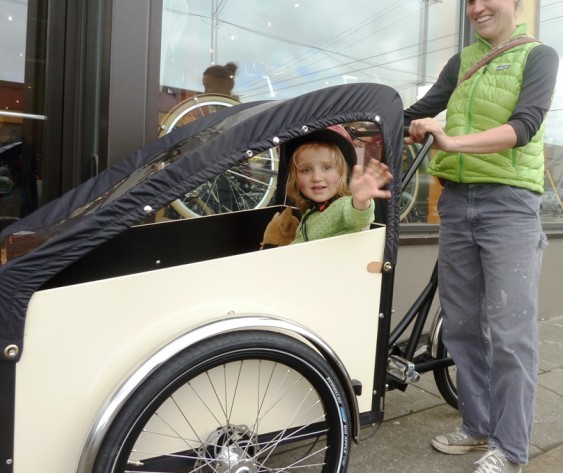
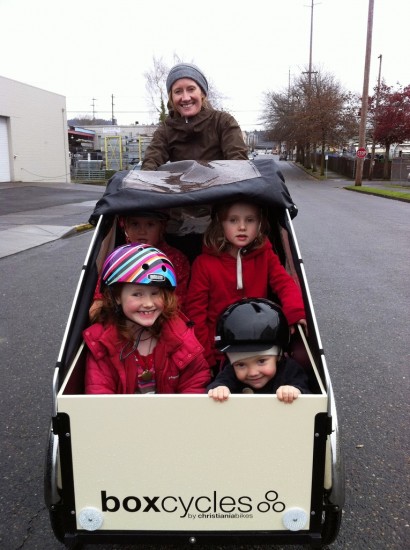
3. Remember kickstands?
Henry Cutler, the Dutch-American owner of WorkCycles in Amsterdam, is convinced that urban cycling will explode once Americans get off high performance bikes and on to bikes that are upright, comfortable, and utilitarian.
“Americans ride bikes that are like race cars; Dutch bikes are like Honda Civics and mini-vans,” Cutler joked last July as I admired his fleet of practical bikes. They come outfitted with child seats, baskets, bells, chain guards, and front and rear lights powered by your pedaling. Oh, and kickstands: why don’t bikes have kickstands anymore?
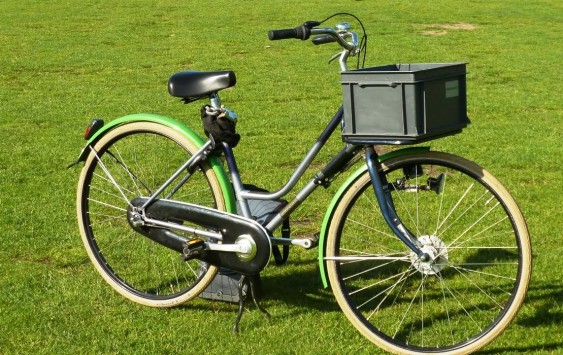
Tom Fuculoro, author of the Seattle Bike Blog, got it right when he wrote recently that buying a bike ought to be more like buying a car. “Most people aren’t fascinated by the technical aspects of car engines; they’re sold by the sunroof or cup-holders.”
David Schmidt, owner of The Dutch Bike Shop in Seattle, reports that the useful bike trend is gaining steam. “Ninety percent of our clients haven’t ridden a bike since they were kids. They’re rediscovering cycling because it’s fun and simpler than driving. These aren’t the crusader commuters. They’re just people who want to start biking to the grocery store.”

4. Does your city have a bike culture?
North Americans all understand what “car culture” means, but it’s a term that increasingly comes with a negative connotation. Cars are now being called an “older generation technology.” Despite the billion-dollar marketing budgets of car companies, many millennials would rather not own a car.
Unlike car cultures, bicycle cultures are in demand. Many of the world’s most vibrant and thriving cities are going to great lengths to support their citizen cyclists because having a “bicycle culture” has suddenly become an asset and an important part of “attracting the types of workers that an innovation economy wants to attract.”

Brian Surratt, business development director at the City of Seattle’s Office of Economic Development, recently spoke about the importance of developing a bike culture because, as he put it, “demographics is destiny. People no longer relocate for industry. Industry relocates for talent. Seattle wants to be recognized as a bike-friendly city because it simply helps attract good talent. The most successful cities—economically, culturally, and socially—must compete for intellectual capital and talent.”

5. More cyclists equals more compassionate roads.
Numerous studies document the relationship between an increase in the volume of cyclists and an increase in cyclist safety. The relationship between these two factors is sometimes remarkably linear.

Odense, Denmark, for example, embarked on an ambitious, multi-year cycling promotion campaign and saw cycling levels increase by 20 percent, while traffic accidents involving cyclists decreased by 20 percent. Why? People behind the wheel become more accustomed to seeing people on two wheels on the roads. Also, it’s often the same people: drivers and cyclists are the same folks at different times of the day, or at least drivers are more likely to have cyclists in the family. Driving “with your heart” becomes a much easier sell when citizens—like in Groningen, Holland—have friends and family members who commute by bike or on foot.
Lucky for us, cycling rates have increased dramatically in many Cascadian cities: bike commuting doubled in Seattle and tripled in Portland as a share of all commutes from 2000 to 2010, according to the League of American Bicyclists. This growth helps make roads a lot safer for everyone—even roads that lack cycling infrastructure.

6. We don’t have time to compensate.
Most people reading this article are sitting in front of a computer. More and more of us are “knowledge workers” who sit in front of computers for much of our careers. If you also choose to use passive forms of transportation such as driving or taking the bus, doctors recommend that you compensate for your sedentary lifestyle by “working out.”
Unfortunately, I don’t find much time in my schedule to compensate—and I’m not alone. The Center for Disease Control reports that 80 percent of Americans fail to meet federal guidelines for physical activity, despite the $19 billion we shell out for gym memberships each year.
Why can’t activity just be engineered into our daily lives so that we can stay healthy without the added chore of working out? Cycling has been the solution for me. I typically burn about 500 calories a day pedaling myself to the places I need to go, and going to the gym is never on the to-do list anymore. Having one less chore means I have more free time to spend with the people I love.
7. Focus on women.
Women are the “indicator species” of a city’s cycling ecosystem. Studies have shown that women are more risk-averse than men, so a profusion of women pedaling in a city shows that cycling feels safe there.
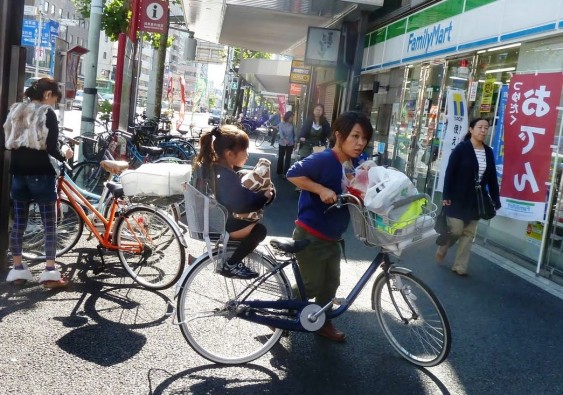
Women are also far more likely to participate in and benefit from cycling encouragement and training programs than men. A study done in London showed that 73 percent of London residents who participated in on-road cycling training programs were women. The same study interviewed female cyclists and found that “cycling helps bolster a self-confident, independent identity” for many women.
An Australian study shows that cycling outreach and support events have a greater positive impact on behavior change among women than among men. Why else is it important to get more women riding? American women make more major household decisions than men do and can hence influence the entire family to get out of the car and onto bikes. Some people also assert that more women cycling can contribute to a more visually pleasing urban environment.

None of these ideas is revolutionary. I’ve witnessed each across the world. What’s important is that sometimes it’s not just about infrastructure. Getting folks to fall in love with cycling will take more than signage and street paint (although those are important, too!).
What bicycling could really use is a good marketing department.
[button link='{“url”:”http://www.sightline.org/2012/01/23/two-wheels-and-high-heels/”,”title”:”Like what you|apos;re reading? Check out more great cycling tips from Christine Grant here.”}’]
All photos are courtesy of the author unless otherwise noted.
Christine M. Grant is a senior associate at Collaborative Efficiency. You can learn more about her travels and see more of her pictures of great cycling cities on Shift, her personal blog.
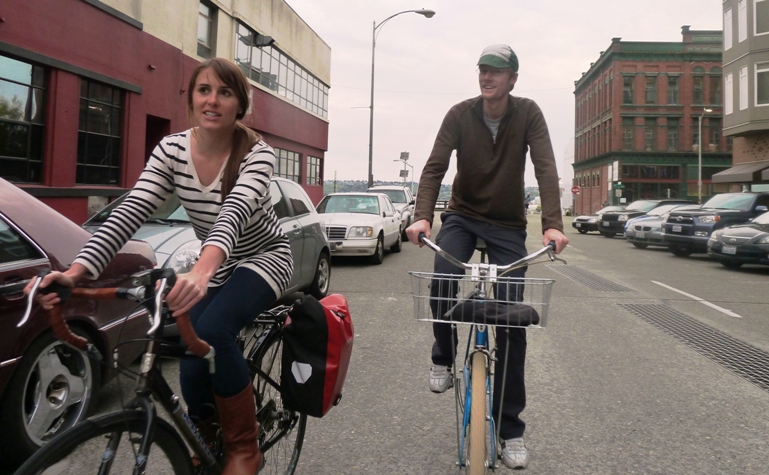

Comments are closed.